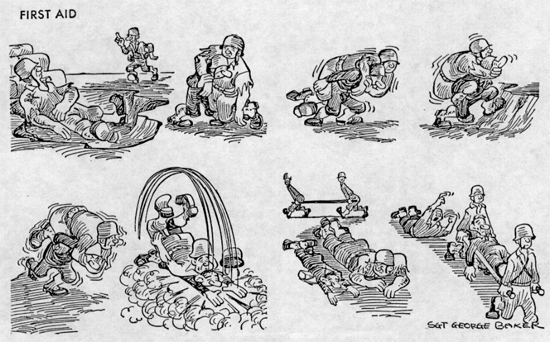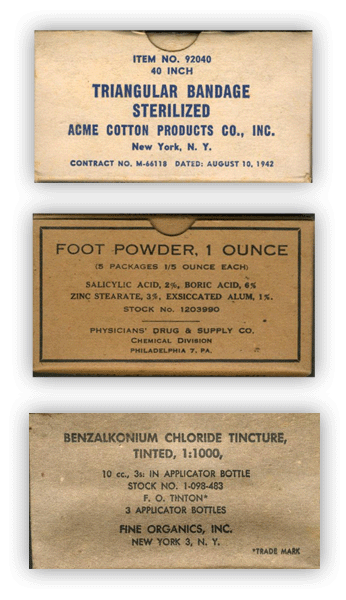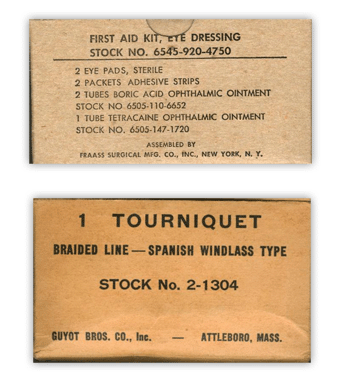Background to Medical Item Numbers

“The SAD SACK”, by Sergeant George BAKER, Simon & Schuster Inc., New York 20, N.Y., 1944 (cartoon drawn by Sgt G. Baker 1915-1975)
The Classification of Items
| Class 1 | 10010 – 15440 | Drugs, chemicals, biological stains. |
| 15900 – 18280 | Biological products. | |
| Class 2 | 20010 – 20420 | Surgical dressings. |
| Class 3 | 30010 – 35590 | Surgical instruments. |
| 36010 – 38910 | Surgical appliances, miscellaneous diagnostic instruments and surgical supplies. | |
| Class 4 | 40010 – 44910 | Laboratory equipment and supplies. |
| Class 5 | 50020 – 57030 | Dental equipment and supplies. |
| Class 6 | 60020 – 61730 | X-ray equipment and supplies. |
| Class 7 | 70000 – 71012 | Furniture. |
| 71020 – 71390 | Physiotherapy equipment. | |
| 71510 – 71780 | Hospital linen and bedding. | |
| 72010 – 74320 | Mess equipment and supplies. | |
| 74510 – 74955 | Cleaning and preserving equipment and supplies. | |
| 75020 – 76700 | Stationary and miscellaneous office equipment and supplies. | |
| 77010 – 79550 | Miscellaneous hospital equipment and supplies. | |
| Class 8 | 80010 – 81413 | Veterinary equipment and supplies. |
| Class 9 | 91010 – 99630 | Field equipment and supplies. |
Remark:
Supplemental Drug Medical Items formerly listed in Class 1K and the biological stains formerly numbered from 15200 to 15440 inclusive, have been renumbered as Class 1 or Class 9 Items; they may still appear in some Manuals published and issued before mid-1944. A typical example, taken at random is: TM 8-285 War Department Technical Manual, “Treatment of Casualties from Chemical Agents”, War Department, 15 April 1944 listing medical items for first-aid and treatment of Chemical Warfare casualties, such as Item No. 1K24810 – Eye Solution BAL, 1/2 oz., with Separate Dropper which became Item No. 9109525 – Eye Solution, BAL, 1/2 oz., with separate Dropper.
Likewise, some Spare Parts Kits used for Stoves and Burners can be identified under ‘special’ combined numbers, such as indicated in TM 8-615 War Department Technical Manual, “Gasoline Stoves and Burners”, War Department, 25 May 1945 listing such items as Medical Department Kit No. 9R10295, Medical Department No. 9R10005, Manufacturer’s No. 527, Burner One 2,500 B.T.U. Head (including: 3 Vaporizer Assembly – Item No. 9R10330, 1 Filler Plug Gasket – Item No. 9R10304, 1 Valve Stem Packing – Item No. 9R10322, 1 Pump Leather – Item No. 9R10308)

Triangular Bandage, Item No. 92040 – 5-digit number, dating item before March 1944
Foot Powder, Item No. 1203990 – 7-digit number dating item after March 1944
Benzalkonium Chloride Tincture Tinted, Stock No. 1-098-483 – 7-digit hyphenated sequence, dating item after July 1947

First Aid Kit Eye Dressing, Stock No. 6545-920-4750 – 11-digit hyphenated sequence, dating item early 1950 (new Federal Stock Number)
Tourniquet, Stock No. 2-1304 – typical numbering sequence applied by the US Navy
Medical Item Numbering System:
While the United States Army preferred to indicate itemized parts by Stock Number, the Medical Department used Item Numbers. The following series of digits represent the numbering system in use during WW2. During the early phase of WW2, most Item Numbers only had 5 digits. Early 1944 the number of digits increased from 5 to 7. The first digit always indicated the class to which the part belonged, while the other four (i.e. 0001 to 9999) indicated the purchase order within a specific class. The new Army Service Forces Medical Supply Catalog dated 1 March 1944, officially lists the increased series of digits, i.e. 7 instead of only 5; the additional two digits were attributed in order to help identify variants among identical medical items, and the very last two digits were used for this specific purpose (i.e. 00 to 99); when a particular item had no variants, both last digits were always double zero (00).
The Medical Supply Catalog, dated 1 March 1944, lists contents with 7-digit Item Numbers. Since this Catalog superseded former publications introduced 1 June 1943, it would imply that the existing system (5-digits) was gradually modified into a 7-digit numbering system over this period, i.e. between mid 1943 and early 1944, give or take a few months …
Here follows a typical evolution:
Packet, First-Aid, Parachute or Item No. 97785 (i.e. manufactured before 1944 is now identified as Item No. 9778500 (when officially introduced after 1 March 1944). After WW2, i.e. July 1947, the numbering system changed once more, whereby the 7 digits now appeared in three separate groups, divided by a hyphen, or Item No. 9-226-100; this also entailed a possible change of nomenclature and description, as the item now became designated as First Aid Kit, Parachute.
Medical Form Numbering System:
The United States Army categorized official forms and documents by using a similar system to that used in the Medical Item Classifications. Form Numbers took the form of “Digit 1 – hyphen – 2, or 3 Digits”. The first digit of the form number would indicate which BoS (Branch of Service) the form pertained to, 8 being reserved for forms exclusive to the Medical Department.
Internal Medical Department forms however were itemized simply by a series of alpha-numerical characters. So for example, a form which had only one variant, and had not been amended was classified as Form ## (i.e. Form 14 – Daily journal of receipts and issues (MSD) ). However, forms which had a number of variants, or which had been amended or modified were itemized by the addition of a series of proceeding numbers and digits. The following example is based on Form 52:
Form 52a – Index of patients (card)
Form 52b – Emergency Medical Tag (20 in Booklet in Duplicate)
Form 52c – Field medical card
Form 52d – Field medical record jacket
